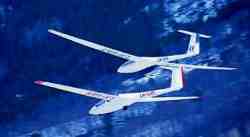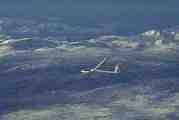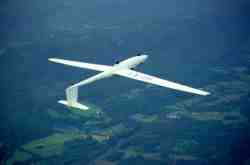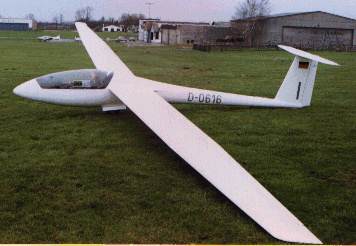silence and grace
In my spare time I try to find the time to go gliding, or soaring as some call it, in sailplanes.
 It started about seven years ago
when I spent two weeks taking a basic course in flying
gliders.
It started about seven years ago
when I spent two weeks taking a basic course in flying
gliders.
The first single-seat glider I flew was the Alexander
Schleicher K-8b which is an rather old rag and tube
glider but easy to fly and handle. Climbs like a cork in
termals but not very good for cross-country flying. You
better keep the airfield in sight.
I then moved on to fibre-glass glider who in many ways are easier to fly than the old ones. You don't have to use the rudders so much. More effective and harmonic. Often during aero-tow there were not enough ailerons on the K-8. But the "glass" glider is more unforgiving if you screw up.
 My favourite gliders are the Schleicher
ASK-21 which is a beauty both to look at and to fly.
Fully aerobatic too. It's a twin-seat glider so you may
fly with a friend and thus enjoy the flying more.
My favourite gliders are the Schleicher
ASK-21 which is a beauty both to look at and to fly.
Fully aerobatic too. It's a twin-seat glider so you may
fly with a friend and thus enjoy the flying more.
 The ASK-21 on top of a loop.
The ASK-21 on top of a loop.
 The other favourite glider is the
Rolladen-Schneider LS-6. Mostly because it is so
beautiful to look at. Rather tricky to fly, to get the
most out of I that is. It's one of the worlds top class
gliders only beaten by the Schempp-Hirth Discus b some
times. The newer LS-7 wasn't too much of a sucess and
Rolladen-Schneider constructed the LS-8 which is more or
less a flapless LS-6 wing with a LS-7 fuselage which is a
real performer.
The other favourite glider is the
Rolladen-Schneider LS-6. Mostly because it is so
beautiful to look at. Rather tricky to fly, to get the
most out of I that is. It's one of the worlds top class
gliders only beaten by the Schempp-Hirth Discus b some
times. The newer LS-7 wasn't too much of a sucess and
Rolladen-Schneider constructed the LS-8 which is more or
less a flapless LS-6 wing with a LS-7 fuselage which is a
real performer.
For those who wonder......
What makes a
glider fly?
It IS possible to fly for hours without the help
of an engine. Becuase the glider has no engine, it is all
the time flying "downhill". But the air around
the glider is in movement almost all the time, either
upwards, downwards or horizontally. Glider pilots takes
advantage of the vertical movement of the air to be able
to fly for long periods of time. The trick is to find
areas where the air is moving upwards. To find those
areas it is important to know what causes this movement.
Rising air, called "climb" (the opposite is
called "sink") is divided into three
categories:
Hang
Hang is the most simple form of climb. When the
wind blows against a ridge or a mountain, the air will be
forced upwards. This climb is used by glider pilots to
fly just in front of, and over the ridge. You can find
hang all year around as long as it is blowing enough. The
disadvantage is that the hang is very dependant of the
nature of the ridge and it is therefore a limit of how
high it is possible to get on a hang.
 In
addition it is not possible to fly away from the ridge
and still climb. The advantage is that hang is easy to
find. If you know the direction the wind is blowing it's
only to fly against the ridges facing the wind (almost).
The difficulty is to find out how the wind is blowing.
In
addition it is not possible to fly away from the ridge
and still climb. The advantage is that hang is easy to
find. If you know the direction the wind is blowing it's
only to fly against the ridges facing the wind (almost).
The difficulty is to find out how the wind is blowing.
Termals
Termals is maybe the most frequently used forms
of climb. When the sun shines it will heat the ground
differently depending on the surface and how the surface
is positioned in relation to the sun. The ground will
then heat up the air differently. The hottest air, who is
lighter than the surrounding air, starts to rise. If
meteorological conditions are favourable (unstable air)
this "bubble" of air will continue rising. This
rising air "bubble" is used by the gliders to
climb by circling inside the "bubble". Termals
is usually found in spring and in summer when the
intensity of the sun is strongest. Termal
"bubbles" are often identified by a cauliflower
(cumulus) cloud on top of it.
Waves
Waves is the form of climb where you can get the
highest altitude.
 Waves are formed by the wind
setting the air in motion behind a mountain. By flying on
the front edge of this wave you may reach altitudes of up
to 10.000 meters which is the normal cruise altitude of
airliners! Waves are most common during autumn and spring
and many gliding clubs arrage "Wave Camps"
during Easter.
Waves are formed by the wind
setting the air in motion behind a mountain. By flying on
the front edge of this wave you may reach altitudes of up
to 10.000 meters which is the normal cruise altitude of
airliners! Waves are most common during autumn and spring
and many gliding clubs arrage "Wave Camps"
during Easter.
There are also combinations of this forms of climb.
For those wondering how it is like to fly gliders in Norway shuold try this link to the homepage of our national gliding association to get some information.
This year has been a busy one and I haven't been flying much, but I hope next year will be better, spare time concerned. Here are a link to my gliding club and a more good links for glider pilots may be found in the aviation links section.